[English] 日本語
 Yorodumi
Yorodumi- PDB-1foe: CRYSTAL STRUCTURE OF RAC1 IN COMPLEX WITH THE GUANINE NUCLEOTIDE ... -
+ Open data
Open data
- Basic information
Basic information
| Entry | Database: PDB / ID: 1foe | ||||||
|---|---|---|---|---|---|---|---|
| Title | CRYSTAL STRUCTURE OF RAC1 IN COMPLEX WITH THE GUANINE NUCLEOTIDE EXCHANGE REGION OF TIAM1 | ||||||
 Components Components |
| ||||||
 Keywords Keywords | signaling protein / immune system/signaling protein / DBL HOMOLOGY DOMAIN / PLECKSTRIN HOMOLOGY DOMAIN / GTPASE / GUANINE NUCLEOTIDE EXCHANGE FACTOR / immune system-signaling protein COMPLEX | ||||||
| Function / homology |  Function and homology information Function and homology informationbrain-derived neurotrophic factor receptor signaling pathway / regulation of non-canonical Wnt signaling pathway / regulation of dopaminergic neuron differentiation / RAC3 GTPase cycle / CDC42 GTPase cycle / RAC2 GTPase cycle / EPH-ephrin mediated repulsion of cells / NRAGE signals death through JNK / EPHB-mediated forward signaling / RAC1 GTPase cycle ...brain-derived neurotrophic factor receptor signaling pathway / regulation of non-canonical Wnt signaling pathway / regulation of dopaminergic neuron differentiation / RAC3 GTPase cycle / CDC42 GTPase cycle / RAC2 GTPase cycle / EPH-ephrin mediated repulsion of cells / NRAGE signals death through JNK / EPHB-mediated forward signaling / RAC1 GTPase cycle / embryonic olfactory bulb interneuron precursor migration / anatomical structure arrangement / regulation of ERK5 cascade / angiotensin-activated signaling pathway involved in heart process / positive regulation of ovarian follicle development / cerebral cortex GABAergic interneuron development / regulation of respiratory burst / G alpha (12/13) signalling events / auditory receptor cell morphogenesis / cerebral cortex radially oriented cell migration / erythrocyte enucleation / regulation of neutrophil migration / negative regulation of interleukin-23 production / localization within membrane / Activated NTRK2 signals through CDK5 / RHOA GTPase cycle / interneuron migration / regulation of hydrogen peroxide metabolic process / kinocilium / regulation of cell adhesion involved in heart morphogenesis / negative regulation of receptor-mediated endocytosis / ruffle assembly / engulfment of apoptotic cell / NTRK2 activates RAC1 / Inactivation of CDC42 and RAC1 / NADPH oxidase complex / cochlea morphogenesis / regulation of neuron maturation / respiratory burst / WNT5:FZD7-mediated leishmania damping / SEMA3A-Plexin repulsion signaling by inhibiting Integrin adhesion / cortical cytoskeleton organization / positive regulation of skeletal muscle acetylcholine-gated channel clustering / cell-cell contact zone / hepatocyte growth factor receptor signaling pathway / GTP-dependent protein binding / activation of GTPase activity / midbrain dopaminergic neuron differentiation / epithelial cell morphogenesis / cell projection assembly / positive regulation of bicellular tight junction assembly / ruffle organization / regulation of lamellipodium assembly / thioesterase binding / regulation of stress fiber assembly / negative regulation of fibroblast migration / regulation of neuron migration / RHO GTPases activate CIT / cell-cell junction organization / motor neuron axon guidance / sphingosine-1-phosphate receptor signaling pathway / Nef and signal transduction / positive regulation of axonogenesis / PCP/CE pathway / RHO GTPases activate KTN1 / Activation of RAC1 / MET activates RAP1 and RAC1 / regulation of nitric oxide biosynthetic process / DCC mediated attractive signaling / Sema4D mediated inhibition of cell attachment and migration / hyperosmotic response / Azathioprine ADME / Ephrin signaling / CD28 dependent Vav1 pathway / positive regulation of ruffle assembly / positive regulation of cell-substrate adhesion / positive regulation of neutrophil chemotaxis / Wnt signaling pathway, planar cell polarity pathway / superoxide anion generation / regulation of GTPase activity / lamellipodium assembly / regulation of receptor signaling pathway via JAK-STAT / small GTPase-mediated signal transduction / NRAGE signals death through JNK / Activation of RAC1 downstream of NMDARs / dendrite morphogenesis / Rho GDP-dissociation inhibitor binding / regulation of cell size / synaptic transmission, GABAergic / positive regulation of Rho protein signal transduction / positive regulation of dendritic spine development / establishment or maintenance of cell polarity / pericentriolar material / positive regulation of actin filament polymerization / Rac protein signal transduction / RHO GTPases activate PAKs / semaphorin-plexin signaling pathway / ficolin-1-rich granule membrane / regulation of postsynapse assembly / Sema3A PAK dependent Axon repulsion Similarity search - Function | ||||||
| Biological species |   Homo sapiens (human) Homo sapiens (human) | ||||||
| Method |  X-RAY DIFFRACTION / X-RAY DIFFRACTION /  SYNCHROTRON / Resolution: 2.8 Å SYNCHROTRON / Resolution: 2.8 Å | ||||||
 Authors Authors | Worthylake, D.K. / Rossman, K.L. / Sondek, J. | ||||||
 Citation Citation |  Journal: Nature / Year: 2000 Journal: Nature / Year: 2000Title: Crystal structure of Rac1 in complex with the guanine nucleotide exchange region of Tiam1. Authors: Worthylake, D.K. / Rossman, K.L. / Sondek, J. | ||||||
| History |
|
- Structure visualization
Structure visualization
| Structure viewer | Molecule:  Molmil Molmil Jmol/JSmol Jmol/JSmol |
|---|
- Downloads & links
Downloads & links
- Download
Download
| PDBx/mmCIF format |  1foe.cif.gz 1foe.cif.gz | 440.8 KB | Display |  PDBx/mmCIF format PDBx/mmCIF format |
|---|---|---|---|---|
| PDB format |  pdb1foe.ent.gz pdb1foe.ent.gz | 359.6 KB | Display |  PDB format PDB format |
| PDBx/mmJSON format |  1foe.json.gz 1foe.json.gz | Tree view |  PDBx/mmJSON format PDBx/mmJSON format | |
| Others |  Other downloads Other downloads |
-Validation report
| Summary document |  1foe_validation.pdf.gz 1foe_validation.pdf.gz | 429.5 KB | Display |  wwPDB validaton report wwPDB validaton report |
|---|---|---|---|---|
| Full document |  1foe_full_validation.pdf.gz 1foe_full_validation.pdf.gz | 514.7 KB | Display | |
| Data in XML |  1foe_validation.xml.gz 1foe_validation.xml.gz | 53.1 KB | Display | |
| Data in CIF |  1foe_validation.cif.gz 1foe_validation.cif.gz | 78.6 KB | Display | |
| Arichive directory |  https://data.pdbj.org/pub/pdb/validation_reports/fo/1foe https://data.pdbj.org/pub/pdb/validation_reports/fo/1foe ftp://data.pdbj.org/pub/pdb/validation_reports/fo/1foe ftp://data.pdbj.org/pub/pdb/validation_reports/fo/1foe | HTTPS FTP |
-Related structure data
| Similar structure data |
|---|
- Links
Links
- Assembly
Assembly
| Deposited unit | 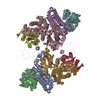
| ||||||||||
|---|---|---|---|---|---|---|---|---|---|---|---|
| 1 | 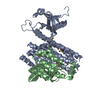
| ||||||||||
| 2 | 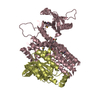
| ||||||||||
| 3 | 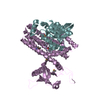
| ||||||||||
| 4 | 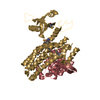
| ||||||||||
| 5 |
| ||||||||||
| 6 | 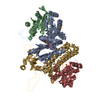
| ||||||||||
| 7 | 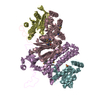
| ||||||||||
| Unit cell |
| ||||||||||
| Details | The biological assembly is a heterodimer composed of a Tiam1 Dbl/pleckstrin element (chains A,C,E,G) in complex with a Rac1 molecule (Chains B,D,F,H). There are 4 heterodimers in the crystal asymmetric unit |
- Components
Components
| #1: Protein | Mass: 43827.539 Da / Num. of mol.: 4 Fragment: RESIDUES 1033 TO 1406 FROM MURINE T-LYMPHOMA INVASION AND METASTASIS FACTOR 1, PLECKSTRIN HOMOLOGY DOMAIN Mutation: ALA-MET-GLY CLONING ARTIFACT ADDED TO N-TERMINUS Source method: isolated from a genetically manipulated source Details: ALA-MET-GLY CLONING ARTIFACT ADDED TO N-TERMINUS / Source: (gene. exp.)   #2: Protein | Mass: 19710.764 Da / Num. of mol.: 4 / Fragment: RESIDUES 1 TO 177 FROM HUMAN RAC1 Source method: isolated from a genetically manipulated source Source: (gene. exp.)  Homo sapiens (human) / Plasmid: PET-15B / Production host: Homo sapiens (human) / Plasmid: PET-15B / Production host:  #3: Chemical | ChemComp-SO4 / #4: Water | ChemComp-HOH / | Has protein modification | Y | |
|---|
-Experimental details
-Experiment
| Experiment | Method:  X-RAY DIFFRACTION / Number of used crystals: 1 X-RAY DIFFRACTION / Number of used crystals: 1 |
|---|
- Sample preparation
Sample preparation
| Crystal | Density Matthews: 3.51 Å3/Da / Density % sol: 64.95 % | ||||||||||||||||||||||||||||||||||||
|---|---|---|---|---|---|---|---|---|---|---|---|---|---|---|---|---|---|---|---|---|---|---|---|---|---|---|---|---|---|---|---|---|---|---|---|---|---|
| Crystal grow | Temperature: 277 K / Method: vapor diffusion / pH: 6 Details: PEG 3350, Li2SO4, MES, glycerol, pH 6.0, VAPOR DIFFUSION, temperature 277.0K | ||||||||||||||||||||||||||||||||||||
| Crystal grow | *PLUS Temperature: 4 ℃ / Method: vapor diffusion, sitting drop | ||||||||||||||||||||||||||||||||||||
| Components of the solutions | *PLUS
|
-Data collection
| Diffraction | Mean temperature: 100 K | ||||||||||||
|---|---|---|---|---|---|---|---|---|---|---|---|---|---|
| Diffraction source | Source:  SYNCHROTRON / Site: SYNCHROTRON / Site:  NSLS NSLS  / Beamline: X4A / Wavelength: 0.9729,0.9787,0.9724 / Beamline: X4A / Wavelength: 0.9729,0.9787,0.9724 | ||||||||||||
| Detector | Type: ADSC QUANTUM 4 / Detector: CCD / Date: Aug 16, 1999 | ||||||||||||
| Radiation | Protocol: SINGLE WAVELENGTH / Monochromatic (M) / Laue (L): M / Scattering type: x-ray | ||||||||||||
| Radiation wavelength |
| ||||||||||||
| Reflection | Resolution: 2.8→15 Å / Num. all: 80441 / Num. obs: 80441 / % possible obs: 93.8 % / Observed criterion σ(F): 0 / Observed criterion σ(I): 0 / Redundancy: 4.7 % / Biso Wilson estimate: 63.6 Å2 / Rmerge(I) obs: 0.069 / Net I/σ(I): 27.9 | ||||||||||||
| Reflection shell | Resolution: 2.8→2.9 Å / Redundancy: 2.9 % / Rmerge(I) obs: 0.392 / Num. unique all: 5874 / % possible all: 68.9 | ||||||||||||
| Reflection | *PLUS % possible obs: 94.2 % / Num. measured all: 382085 | ||||||||||||
| Reflection shell | *PLUS % possible obs: 68.9 % / Mean I/σ(I) obs: 4.3 |
- Processing
Processing
| Software |
| |||||||||||||||||||||||||
|---|---|---|---|---|---|---|---|---|---|---|---|---|---|---|---|---|---|---|---|---|---|---|---|---|---|---|
| Refinement | Resolution: 2.8→15 Å / Cross valid method: THROUGHOUT / σ(F): 0 / σ(I): 0 / Details: Used maximum likelihood target function in CNS
| |||||||||||||||||||||||||
| Refinement step | Cycle: LAST / Resolution: 2.8→15 Å
| |||||||||||||||||||||||||
| Refine LS restraints |
| |||||||||||||||||||||||||
| Software | *PLUS Name: CNS / Version: 0.3 / Classification: refinement | |||||||||||||||||||||||||
| Refinement | *PLUS Highest resolution: 2.8 Å / Lowest resolution: 15 Å / σ(F): 0 / % reflection Rfree: 5 % / Rfactor obs: 0.262 | |||||||||||||||||||||||||
| Solvent computation | *PLUS | |||||||||||||||||||||||||
| Displacement parameters | *PLUS | |||||||||||||||||||||||||
| Refine LS restraints | *PLUS Type: c_angle_deg / Dev ideal: 1.4 |
 Movie
Movie Controller
Controller


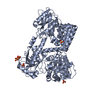
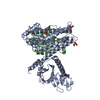
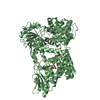



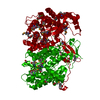

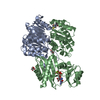
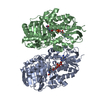
 PDBj
PDBj




















